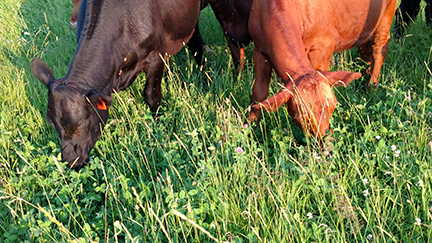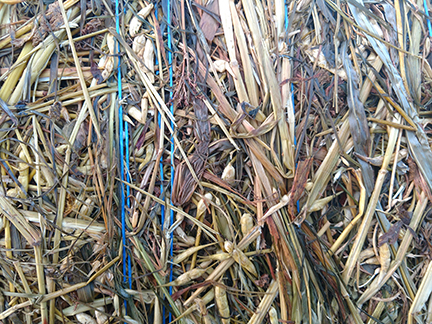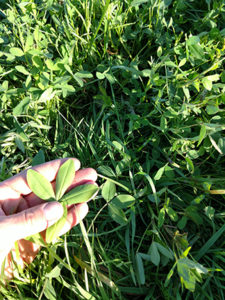by Guest Blogger, Jeremy Sweeten
My name is Jeremy Sweeten and I am a hay/beef farmer in the eastern Upper Peninsula of Michigan, about 20 minutes southwest of Sault Saint Marie, MI. I can see Canada when I look to the north of our farm. We raise about 500 acres of timothy hay, custom raises 100 red and black Angus beef stockers, and custom raise 50-70 cow-calf pairs on 225 acres of pasture. We are also starting a grass-fed herd with five bred heifers this year. My real job is working for The CISCO Companies, Indianapolis, IN, as the northern forage agronomist.
The farm ground in the EUP is flat, heavy, and poorly drained clay and clay loam. The pH on our farm ranges from 5.6 to 6.3. The predominant species are timothy and birdsfoot trefoil. The drainage is accomplished with the use of dead furrows on 40-60’ spacing. I know that cover crops work well for improving soils, so as we redo fields and put drainage back in, I want to use cover crops for soil health improvement. I am always looking for more legumes that will grow in our tough soil and environmental conditions to improve grass growth and add protein to the cattle’s ration.
Frosty berseem clover interested me because of its tolerance for saturated soils low pH, beneficial tannins, and high forage quality. I really wanted to be able to graze my cover crop as well to improve cattle weight gains. I bought 100 lbs of Frosty to try. I used 40 lbs to interested into the existing pasture with red and ladino clover. I used a traditional John Deere 8300 drill to interest my clovers on May 9, 2017. The red clover was seeded at 6 lb/A, ladino at 0.75 lb/A, and the Frosty at 2 lb/A. By May 25, cotyledons were visible from the clover mix.

I used the other 60 lbs of Frosty in a 41 ac cover crop mix that ultimately was 33 acres were mowed and wet wrapped for feed and 8 acres were grazed. The ground was conventionally moldboard plowed to put the drainage furrows every 60’. I used a mixture of BMR forage sorghum, BMR sorghum-sudangrass, buckwheat, field peas, Frosty berseem clover, oats, hairy vetch, a mix of annual and perennial ryegrass, festulolium, and radishes. I cleaned out my old seed inventory but was truly interested in planting a very diverse mixture to kick-start my soils after plowing. The mix was seeded at 40 lbs/ac with the same 8300 drill on June 20.
The growing season was cool and wet. Highs were at best in the mid-70’s and lows dipped into the upper 40’s several nights. Not the most ideal growing conditions. So here is what happened. With the Frosty seeded into the pasture, it took 45-60 days for it to become visible. The cattle ate it very well. After talking with GO, my seeding rate was too low and should have been 6-10 lb/A.
The Frosty Berseem clover in the cover crop mix performed very well. The mix emerged well and came on steadily throughout the summer. When we cut the CC mix in early October, the Frosty was over waist high and growing profusely. The cattle intake on the grazed cover crop was outstanding. I was able to graze the cover crop mix twice. Our growing season is only 120 days, so that was pretty good for spring seeding. I left enough regrowth hoping that the Frosty will regrow next spring. In early November, we had one night of -6F with no snow cover. The ground was not frozen. The Frosty appears to still be growing. I will follow up next spring with what I find.
My final thoughts are as follows. I didn’t have enough grazable cover crop to measure any weight difference on the stockers. Gains across the EUP were off this year due to the poor weather conditions. However, judging by the way they ate the Frosty, I will be planting more as a grazing cover crop. I think I will try the 4-6 lb/A range next year. The Frosty handled the standing water and low pH very well. I think Frosty will help me through the summer slump of timothy and BFT. Nodule growth was very present. The cover crop was brilliant green with no commercial fertilizer. I was not as impressed with overseeding pastures with Frosty. I feel that it doesn’t handle competition or cool, wet soils like red or ladino clovers do. I am confident that Frosty will fit on our farm long term; I just have to learn the best ways to use it.


For a printable, PDF version of this blog, click below.
Experiencing Frosty Berseem Clover in Northern Michigan. PDF

